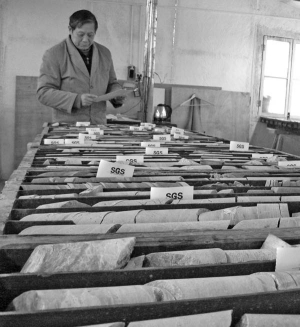Not only is Jinshan Gold Mines (JIN-T, JINFF-o) one of just a handful of foreign mining companies producing gold in China, but the Canadian junior also has some good exploration prospects.
Highlights from the third phase of its drill program at the Dadiangou gold project included 34 metres (26.1 metres true width) of 3.4 grams gold per tonne from hole 08-09 and 24 metres (14.1 metres true width) of 1.6 grams gold per tonne from hole 08-06.
Jinshan hopes to release a new resource update on Dadiangou before the end of the year, but currently the deposit’s main zone contains an estimated inferred resource of 26.3 million tonnes grading 0.92 gram gold per tonne for a total of 778,000 oz. gold.
In an interview on the sidelines of the Denver Gold Forum in September, Roger Walsh, Jinshan’s senior vice-president of corporate development, said he was extremely bullish on China and Jinshan’s unique position as one of the first — and few — foreign mining companies with a track record there.
“Most of the people in this business are biased against China,” he said. “They can’t go to China. They don’t have the people. They don’t have the background. It’s a five-six- seven-eight year thing.”
Jinshan’s powerful shareholders also bring the company access to deal flow, exploration and advanced projects, as well as access to low-cost, unhedged Chinese bank debt, Walsh believes.
China National Gold, a Chinese state-owned enterprise and the largest gold producer in China, owns about 42% of the Canadian junior. And recently China National Gold’s president, Sun Zhaoxue, was appointed as Jinshan’s new chief executive.
China National Gold controls 20% of gold production in China, 30% of its known reserves and operates 65 mines.
“Mr. Sun and China National Gold don’t have to go and invite Barrick or Newmont to come in and help them. The industry is changing from the old days when the government needed us and pleaded with all these guys (mining companies) to come in. . .” Walsh explained.
“There is a huge amount of expertise in China and you’ve probably got the best geological endowment there in the world today,” he continued. “I think their mind-set now is: ‘We’ve got these assets but we need to look at them with Western or capitalistic ideas to see how we can optimize them.”
Jinshan’s Dadiangou gold system is in the central part of China in southern Gansu province within the Qinling fold belt.
Phase three drilling involved 17 diamond-drill holes for 3,045 metres — bringing Jinshan’s total drilling to date to 14,910 metres in 68 holes.
Near-surface portions of its central zone have been drilled off to about 65 by 65-metre spacing. In addition to the infill drilling, two holes (08-01 and 02) were located to target the western extension of the Dadiangou West Zone and increased the known mineralized strike length by over 650 metres to about 4 km.
Both holes encountered low-grade mineralization (0.45 gram gold per tonne over 4.6 metres and 0.42 gram gold per tonne over 3.6 metres, respectively), but illustrated the continuity of the mineralized shear zone.
Once Jinshan completes a revised resource estimate, it expects to finish a preliminary economic assessment and push ahead with an application for a mining licence.
The Dadiangou exploration licence covers about 15 sq. km and is owned by Jinshan’s joint-venture partner, the Northwest Industrial Nuclear Economic Technical Corp., a division of the Shaanxi Nuclear Geology Bureau of China.
The joint-venture agreement allows Jinshan to earn a minimum of 80% on the property, with Northwest Industrial having the option to participate at 20%, or to become diluted.
Jinshan started producing gold at its CSH mine in Inner Mongolia in July 2007. In August, a record month, production reached 6,415 oz. gold.
At presstime, Jinshan traded at about 50 a share. It has a 52-week trading range of 39-$3.22. The Vancouver-based junior has 163.6 million shares outstanding.


Be the first to comment on "Jinshan hitting gold in China’s Gansu province"